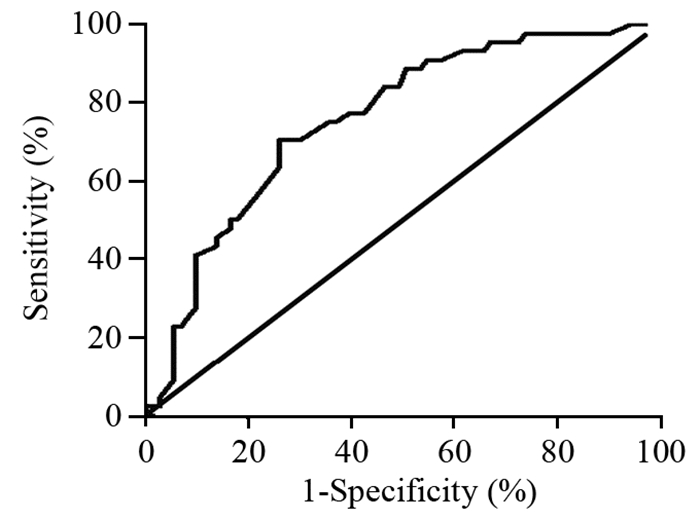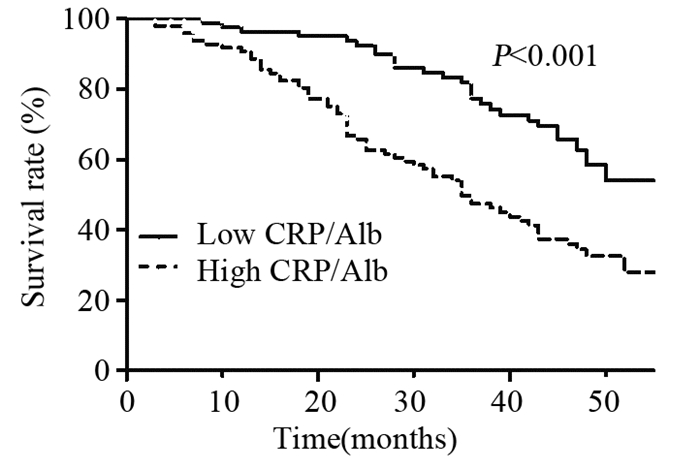
文章信息
- C反应蛋白与白蛋白比值对原发性肝癌患者预后的判断价值
- Predictive Value of C-reactive Protein/Albumin Ratio on Prognosis of Patients with Primary Hepatocellular Carcinoma
- 肿瘤防治研究, 2016, 43(7): 598-601
- Cancer Research on Prevention and Treatment, 2016, 43(7): 598-601
- http://www.zlfzyj.com/CN/10.3971/j.issn.1000-8578.2016.07.011
- 收稿日期: 2015-10-08
- 修回日期: 2015-12-28
2. 430061 武汉,湖北省中医院药剂科
2. Department of Pharmacy, Hubei Provincial Hospital of TCM, Wuhan 430061, China
肝细胞癌(hepatocellular carcinoma, HCC)是我国死亡人数第二位的恶性肿瘤,虽然近年来HCC的筛查和诊疗技术得到长足发展,然而HCC患者的预后仍较差,严重影响了人们的健康[1-2]。研究发现,机体的免疫炎性反应是肿瘤发展的重要病理过程,与预后不良密切相关[3-4]。近来,多种炎症相关的评分被开发用来评价肿瘤患者的预后,例如Glasgow预后评分、中性粒细胞/淋巴细胞比值、预后营养指数等,显示与患者预后密切相关[5]。C反应蛋白(C-reactive protein, CRP)是反映炎性状态的重要指标,白蛋白(Albumin, Alb)由肝脏合成,不仅反映机体的营养状态,还能反映肝功能,既往研究CRP/Alb与败血症患者预后密切相关[6-7]。然而,CRP/Alb是否能够预测HCC患者的预后尚不清楚。为此,本研究通过随访,分析了CRP/Alb与HCC患者预后的关系,为评价这一简便易得的指标的临床意义提供证据。
1 资料与方法 1.1 临床资料选取2011年1月—2014年1月在湖北省肿瘤医院行手术治疗的HCC患者,均经过影像学和组织标本病理切片确诊,按2001年中国抗癌协会肝癌专业委员会制定的《原发性肝癌的临床诊断和分期标准》进行诊断[8]。纳入标准:未经术前辅助治疗的首次手术治疗肝癌患者。排除标准:(1)术前曾行放化疗;(2)术前有感染或炎性疾病;(3)缺乏完整资料;(4)围手术期发生严重并发症或死亡。最终178例患者入选,其中男127例,女51例,平均年龄67.9岁。
1.2 CRP/Alb与临床特征于术前1周内行血清学和影像学检查,根据CRP和Alb水平计算术前CRP/Alb比值。同时纳入其他相关临床特征作为变量,包括丙氨酸氨基转移酶(alanine aminotransferase, ALT)、天门冬氨酸氨基转移酶(aspartate amino transferase, AST)、甲胎蛋白(alphafetoprotein, AFP)、Child-Pugh分级等。
1.3 随访通过电话、门诊和病历资料等方式进行随访,所有病例均随访至2015年6月30日,终点事件定义为因HCC发生的死亡事件,总生存时间为手术时间至随访结束或终点事件发生时。
1.4 统计学方法所有数据均采用SPSS21.0软件分析,计量资料用(x±s)表示,两组比较采用独立样本t检验;计数资料用百分率表示,两组间比较采用χ2检验;用受试者工作特征曲线(receiver operating characteristic curve, ROC)分析变量的预测价值;采用Kaplan-Meier法和Log rank检验进行生存分析,采用Cox比例风险回归模型分析预后的影响因素;以P<0.05为差异有统计学意义。
2 结果 2.1 CRP/Alb的截点平均随访35.6月(19~55月),共有106例(59.6%)患者发生终点事件。根据术前的CRP/Alb建立患者生存状态的ROC曲线,得到的最佳截点为0.46,曲线下面积为0.717,敏感度为70.45%,特异度为73.97%,见图 1。

|
| 图 1 CRP/Alb比值评估原发性肝癌患者生存情况的受试者工作特征曲线 Figure 1 Receiver operating characteristic curves of CRP/Alb ratio on assessing overall survival of HCC patients |
根据0.46的截点,将患者分为高CRP/Alb组(>0.46)和低CRP/Alb组(≤0.46),分别为97例和81例患者。两组患者的平均年龄、性别构成比、ALT、AST、AFP等临床特征相近,差异均无统计学意义(P>0.05)。而与低CRP/Alb组相比,高CRP/Alb组的CRP水平较高、Alb水平较低、Child-Pugh分级较高、肿瘤最长径较大、血管浸润比例较高,差异均有统计学意义(P<0.001),见表 1。
 |
随访结束时,高CRP/Alb组有71例(73.2%)患者发生终点事件,而低CRP/Alb组只有35例(43.2%)。两组的生存率分别为26.8%和56.8%,Kaplan-Meier曲线显示高CRP/Alb组的生存率显著小于低CRP/Alb组,差异有统计学意义(P<0.001),见图 2。Cox多因素回归分析显示,CRP/Alb、Child-Pugh分级、血管浸润是影响患者预后的独立危险因素,见表 2。

|
| 图 2 两组患者生存分析的Kaplan-Meier曲线 Figure 2 Kaplan-Meier curve of survival analysis of two groups |
 |
免疫炎性反应与肿瘤的发生发展关系密切,可能与以下机制相关:肿瘤生长或侵袭的诱导;肿瘤组织坏死和缺氧,局部组织破坏;肿瘤细胞和肿瘤相关因子会诱导炎性因子产生,如肿瘤坏死因子(TNF)、白介素-1(IL-1)、白介素-6(IL-6)、白介素-8(IL-8)和血管内皮生长因子(VEGF),这些炎性因子和趋化因子将会易化肿瘤生长、浸润、转移、血管生成,破坏宿主的免疫反应,以及细胞药物抵抗[9-10]。CRP是在组织损伤等炎性刺激时,由肝脏细胞合成的急性相蛋白质,反映机体的系统炎性反应,高CRP水平是恶性肿瘤不良预后的预测指标[11-14]。白蛋白是反应机体营养状态的重要指标,也由肝脏细胞合成,白蛋白浓度下降常因进行性体重减轻和恶病质导致[15]。在本研究中,我们将CRP和Alb结合,能够综合反映HCC患者的炎性反应和营养状态,有可能预测HCC患者的临床结局。
本研究纳入首次手术的HCC患者,平均随访35.6月,运用ROC曲线计算CRP/Alb预测患者发生终点事件的最佳截点为0.46。采用此方法,一方面立足于本研究的特定人群,具有良好的实用性和科学性。结果显示,ROC曲线下面积为0.717,提示该截点具有一定的临床适用性。通过比较,发现CRP/Alb与疾病临床特征相关,高CRP/Alb患者的Child-Pugh分期更高,表明患者肝功能储备下降。生存分析显示,高CRP/Alb患者的远期生存率较低,多元回归发现,CRP/Alb是HCC患者预后的独立危险因素。Ranzani等发现与单纯CRP相比,CRP/Alb能够更准确地预测败血症患者的预后[16]。Mocellin等给结直肠癌患者补充不饱和脂肪酸,能够降低CRP/Alb,最终预防患者的体重下降[17]。CRP和Alb是临床上简便易得,又十分有用的指标,本研究将其应用扩展到评价HCC患者预后上,结果表明CRP/Alb具有良好的预测价值。Kinoshita等[18]还将CRP/Alb与其他相关炎性积分作对比,发现CRP/Alb与HCC患者的预后关系更加密切,虽然和本研究相比,纳入的人群不一致,但是结果均提示CRP/Alb在评估HCC患者的远期生存上具有良好的临床价值。
综上所述,CRP/Alb能够反应HCC的疾病状态和炎性反应,是HCC患者预后的独立预测因子。下一步需要扩大样本量,并分析治疗前后CRP/Alb的变化,评价CRP/Alb是否能够作为反映疗效的指标,有助于制定HCC的治疗策略,改善其预后。
| [1] | Xiu P, Dong XF, Li XP, et al. Clusterin: Review of research progress and looking ahead to direction in hepatocellular carcinoma[J]. World J Gastroenterol, 2015, 21 (27) : 8262–70. DOI:10.3748/wjg.v21.i27.8262 |
| [2] | Hsu CS, Chao YC, Lin HH, et al. Systematic Review: Impact of Interferon-based Therapy on HCV-related Hepatocellular Carcinoma[J]. Sci Rep, 2015, 5 : 9954. DOI:10.1038/srep09954 |
| [3] | Shalapour S, Karin M. Immunity, inflammation, and cancer: an eternal fight between good and evil[J]. J Clin Invest, 2015, 125 (9) : 3347–55. DOI:10.1172/JCI80007 |
| [4] | Mischinger J, Comperat E, Schwentner C, et al. Inflammation and Cancer: What Can We Therapeutically Expect from Checkpoint Inhibitors?[J]. Curr Urol Rep, 2015, 16 (9) : 532. |
| [5] | Parisi I, O’Beirne J, Tsochatzis E. Inflammation-based scores and hepatocellular carcinoma[J]. Liver Transpl, 2014, 20 (12) : 1529–30. |
| [6] | Kim MH, Ahn JY, Song JE, et al. The C-Reactive Protein/Albumin Ratio as an Independent Predictor of Mortality in Patients with Severe Sepsis or Septic Shock Treated with Early Goal-Directed Therapy[J]. PLoS One, 2015, 10 (7) : e132109. |
| [7] | Patel A, Laffan MA, Waheed U, et al. Randomised trials of human albumin for adults with sepsis: systematic review and meta-analysis with trial sequential analysis of all-cause mortality[J]. BMJ, 2014, 349 : g4561. DOI:10.1136/bmj.g4561 |
| [8] | Chinese Society of Liver Cancer. The standard of clinical diagnosis and staging of primary liver cancer[J]. Zhonghua Gan Zang Bing Za Zhi, 2001, 9 (6) : 324. [中国抗癌协会肝癌专业委员会. 原发性肝癌的临床诊断与分期标准[J]. 中华肝脏病杂志,2001, 9 (6) : 324. ] |
| [9] | Balkwill FR, Mantovani A. Cancer-related inflammation: common themes and therapeutic opportunities[J]. Semin Cancer Biol, 2012, 22 (1) : 33–40. DOI:10.1016/j.semcancer.2011.12.005 |
| [10] | Allavena P, Germano G, Marchesi F, et al. Chemokines in cancer related inflammation[J]. Exp Cell Res, 2011, 317 (5) : 664–73. DOI:10.1016/j.yexcr.2010.11.013 |
| [11] | Gao X, Zuo G, Guo L. Clinical application of serum C-reactive protein in patients with malignant tumor[J]. Zhen Duan Xue Li Lun Yu Shi Jian, 2004, 3 (1) : 39–40. [高翔, 左桂兰, 郭林. 血清C反应蛋白在恶性肿瘤中的临床应用[J]. 诊断学理论与实践,2004, 3 (1) : 39–40. ] |
| [12] | Chan DS, Bandera EV, Greenwood DC, et al. Circulating C-reactive protein and breast cancer risk- systematic literature review and meta-analysis of prospective cohort studies[J]. Cancer Epidemiol Biomarkers Prev, 2015, 24 (10) : 1439–49. DOI:10.1158/1055-9965.EPI-15-0324 |
| [13] | Wang WD, Fan RF, Han Q, et al. Correlation between Postoperative early recurrence and preoperative serum C-reactive protein level in patients with hepatocellular carcinoma[J]. Zhongguo Zhong Liu Lin Chuang, 2006, 33 (17) : 982–4. [王卫东, 范瑞芳, 韩庆, 等. 肝细胞癌术前血清C-反应蛋白水平与术后早期复发的关系[J]. 中国肿瘤临床,2006, 33 (17) : 982–4. ] |
| [14] | Wu LQ, Wan ZS, Han B, et al. The relationship between preoperative serum C reactive protein level and both of clinical pathological factors and survival rate after hepatectomy in patients with primary hepatocellular carcinoma[J]. Shandong Yi Yao, 2010, 50 (10) : 34–5. [吴力群, 王祖森, 韩冰, 等. 术前血清C反应蛋白水平与原发性肝癌患者临床病理因素及肝切除术后生存率的关系[J]. 山东医药,2010, 50 (10) : 34–5. ] |
| [15] | Arroyo V. Review article: albumin in the treatment of liver diseases-new features of a classical treatment[J]. Aliment Pharmacol Ther, 2002, 16 (Suppl 5) : 1–5. |
| [16] | Ranzani OT, Zampieri FG, Forte DN, et al. C-reactive protein/albumin ratio predicts 90-day mortality of septic patients[J]. PLoS One, 2013, 8 (3) : e59321. DOI:10.1371/journal.pone.0059321 |
| [17] | Mocellin MC, Pastore e Silva Jde A, Camargo Cde Q, et al. Fish oil decreases C-reactive protein/albumin ratio improving nutritional prognosis and plasma fatty acid profile in colorectal cancer patients[J]. Lipids, 2013, 48 (9) : 879–88. DOI:10.1007/s11745-013-3816-0 |
| [18] | Kinoshita A, Onoda H, Imai N, et al. The C-reactive protein/albumin ratio, a novel inflammation-based prognostic score, predicts outcomes in patients with hepatocellular carcinoma[J]. Ann Surg Oncol, 2015, 22 (3) : 803–10. DOI:10.1245/s10434-014-4048-0 |
 2016, Vol. 43
2016, Vol. 43


